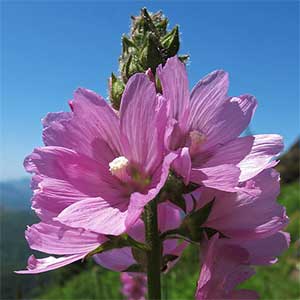Sidalcea hirtipes
Sidalcea candida
bluff mallow, bristly-stem checker-mallow, bristly-stem checkerbloom, hairy-stem checkermallow
white checkerbloom, white checkermallow
several, scattered, erect, arising from rhizome apices, usually slightly hollow, densely, harshly bristly-hirsute, hairs stiff, pustular, simple, forked, or stellate, often 2–2.5 mm.
single, clustered in older plants, erect, sometimes branched distally, solid, glabrous or moderately hirsute, hairs retrorse, simple proximally, becoming ± finely stellate-hairy distally.
basal and cauline;
stipules linear-subulate, 6–8 × 1–1.5 mm;
petioles of proximal leaves 20–30 cm, 3 times as long as blades, reduced distally to 1/2 times as long as blades;
blades: basal and proximalmost orbiculate to reniform, shallowly 5–9-lobed, 10–15 × 10–15 cm, thick, base narrowly cordate, lobe margins coarsely crenate-dentate, apex rounded, surfaces coarsely hirsute, hairs stiff;
distal orbiculate, deeply palmately 5–7-lobed, incised ± to base, lobes sometimes lobed again, base cuneate, apex acute, deeply 2–3-toothed, surfaces long-hirsute or with 2–4-rayed, stellate hairs abaxially.
basal and mostly cauline, not evenly arrayed;
stipules deciduous, ovate, 10 × 2–2.5 mm;
petiole (4–)6–18 cm, usually 1/2 times to as long as blade;
petals often not overlapping, white to pale pinkish, drying yellowish, 10–20 mm;
staminal column 6–9 mm, hairy;
anthers bluish pink;
stigmas 6–9.
erect, spiciform to subcapitate, dense, calyces usually conspicuously overlapping in flower and sometimes in fruit, proximals usually long-pedunculate, unbranched or branched, 20+-flowered, 10+ flowers usually open on spike at same time, not interrupted, not 1-sided, usually to 8 cm, usually not elongate but sometimes slightly elongated in some populations and to 20 cm in fruit;
bracts paired or single, linear, distal undivided, proximal distinct to base, 6 mm, mostly slightly longer than pedicels.
1–3(–5) mm;
involucellar bractlets absent.
bisexual or unisexual and pistillate, plants gynodioecious;
calyx often purple tinted, 9–11 mm, to 11–16 mm in fruit, margins ciliate, hairs 1–2 mm, surfaces finely stellate-hairy at base and with coarser, longer, simple and stellate hairs apically;
petals usually pale pink to rose-lavender, rarely white, slightly or not pale-veined, (9–)10–21 mm, pistillate often 9–14 mm;
staminal column 5–7(–10) mm, hairy;
anthers white;
stigmas 5–10.
2.5–3.5 mm.
2 mm.
7–8 mm diam.;
mericarps 5–10, 3.5–4 mm, glabrous or sparsely stellate-puberulent, roughened, prominently reticulate-veined, sides rugose and pitted, back less so, mucro 0.6–0.8 mm.
5–7 mm diam.;
mericarps 6–9, 3–5.5 mm, sides smooth or slightly reticulate-veined, back less so, not pitted, top minutely hairy, mucro 0.5–0.8 mm.
= 60.
= 20.
Sidalcea hirtipes
Sidalcea candida
Of conservation concern.
Sidalcea hirtipes is uncommon and known from Clatsop, Lincoln, and Tillamook counties in Oregon and Clark, Lewis, and Wahkiakum counties in Washington. Its elevation and habitat vary, and it seems as much at home on steep coastal cliffs as in more inland, historic prairies and mountain meadows. Populations can appear to be large because of the long-rhizomatous and clonal nature of the plants; they are few and local. It is threatened by grazing, loss of habitat, fire suppression, road construction and maintenance, and changes in hydrology. It is a candidate for listing in Oregon and has been listed as endangered in Washington. Sidalcea hirtipes is characterized by its coarse indument of bristle hairs, its generally compact spikelike inflorescences, its relatively few, large, erect, hirsute leaves, and, especially, its extensive, coarse rhizomes. The inflorescences in some populations are elongated in fruit; its range, hirsute indument, and thick leaves along with coarse rhizomes help to distinguish it from other species. Stem internode length varies depending on habitat, as in many other Sidalcea. Molecular data suggest a relationship among S. hirtipes and S. asprella, S. celata, and S. gigantea (K. Andreasen and B. G. Baldwin 2003).
(Discussion copyrighted by Flora of North America; reprinted with permission.)
Sidalcea candida is one of the more eastern species of Sidalcea (along with S. neomexicana) and is also one of the more easily distinguished because of its relatively large, crowded flowers with white petals, deep, wide-spreading rhizomes, pinkish-blue anthers, and nearly glabrous stems and leaves. It has become a popular garden plant. Hitchcock recognized two varieties based on calyx indument, var. candida with the calyx uniformly hairy, and var. glabrata with the calyx much more hairy at the base than on the lobes. Cockerell distinguished plants with somewhat pink petals as var. tincta. These differences do not appear to be taxonomically significant, and the varieties lack geographic coherence.
(Discussion copyrighted by Flora of North America; reprinted with permission.)


